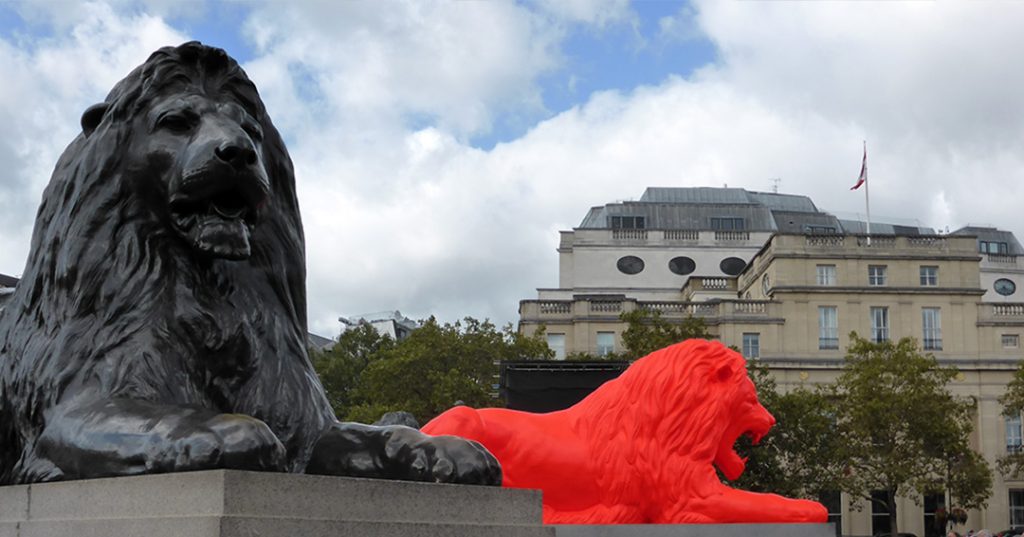Strandlions
Posted in 21st Century, Animal and tagged with Es Devlin, lions, London Design Biennale, Trafalgar Square

Es Devlin’s Poetic Lion and Emotional States
The 2018 London Design Biennale had as its theme ‘Emotional States’. From Argentina to Vietnam, a large group of countries presented ideas, constructions and installations interpreting that theme, mostly in material forms. One distinct work, sponsored by Google Arts & Culture, was Es Devlin’s poetry-roaring lion, installed alongside Landseer’s quartet of lions in Trafalgar Square. They had originally been designed to be rampant lions, but possibly thanks to that peculiar and peculiarly Victorian suspicion of legs, they were turned into couchant lions, looking more docile. When Devlin heard this story about landseer’s lions, she wondered about what they had witnessed since they had taken up their places, and whether that could be made into poetry? The result was a flaming red lion, cast in resin-coated foam from one of the original lions, painted almost fluorescent scarlet, with a screen in its open jaws and a second screen on a stand in front of it. There you type in a word; a bot wordles it into a bot’s version of poetry, and displays it on the screen in the lion’s mouth.
Talking lions are an old idea – the ancient marble mask in Rome known as Bocca della verità or Mouth of Truth represents an old ocean god, but was re-represented as a lion in many northern Renaissance paintings like Lucas Cranach The Elder’s Mouth of Truth (1525-8) which was sold at Sotheby’s in 2015 amid great excitement for £9.3 million. More usually lions mouths’ feature as fountains, as if water poured out like truth. Perhaps it does. The roar coming from Es Devlin’s lions was not much like an animal noise, but more like a booming sound deep under the sea. It’s a wonderful idea to have poetry in public places – imagine Blake poems projected along the Strand! – and when I arrived to meet the lion in leonine person, it was drawing a fair bit of attention.
The lion’s voice doesn’t really ‘say’ the poetry, which is produced by an algorithm using a large vocabulary of words sourced from British poetry of the 1860s, when Landseer’s lions were cast. Devlin collaborated with Ross Goodwin who had worked with her at the V & A at Christmas in 2017, where their project The Singing Tree produced a collective carol. Devlin has said in interviews that for the very public site of Trafalgar Square, she wanted to make a diversely crowd-sourced collective single poetic voice. That might seem a contradiction – single? collective? – but it’s more a sign of the evolving times, the poetic equivalent of a flash mob. Over a week, words fed to the lions join up to become a long poem, some of which is projected up Nelson’s Column each night before the whole project moves online.
There was something pleasing in seeing the red lion alongside its fellows, taking in the comings and goings of Trafalgar Square. It was surprisingly shiny; the gleam of Landseer’s black lions became slippery brightness. Somewhere semi-conscious its red evoked a postbox, waiting for words to be slipped in. To read the screen set into the ground you had to stand north of the lion, which meant looking south to read the screen in its mouth – not ideal for the fall of light, but with a psycho-geographic aptness in facing towards Westminster, the river, away across a wider London. Poetry seemed more likely to spread that way than in the other building-blocked, urban-dense directions.
Devlin titled the project ‘Please Feed the Lions’, as if they were in a zoo. With an emotional state combining excitement and uncertainty, I approached and sized up the screen. The deal was that you could enter any word so long as it was not offensive or a proper name; if it was in the Oxford English Dictionary, fine. Reader, I wrote in strandline. The screen flashed back to say that was an indigestible word. Really? Slightly annoyed, I tried a word most definitely in the OED: mesolithic. I got the same message. Now my emotional state was becoming peeved. Third time lucky? I typed in strand. Yes! There was a pause, and a surge in the strange booming soundscape, and some hard-to-read text rolled up the screen in the lion’s jaws.
Nonetheless, I felt thrilled, as if some supernatural force had acted between my hand and the lion. At least one religion begins with a covenant around a word, and even in this literary petting zoo it felt powerful to have a word given and accepted. Later I double checked my suggestions and need to apologise, twice, to the Lion: mesolithic turns out to be a word first used in 1877, and strand-line in 1910. Who knew! Indeed in looking up strand in the OED, I learnt it was first recorded as the London street name or foreshore area in 1246. And that among a collection of strand-linked words is this discovery: on the stormy coasts of the Hebrides, fishermen find objects like flat chestnuts which they call strand-nuts. The date is 1860. I wish I had known that: I imagine the Lion already did.

